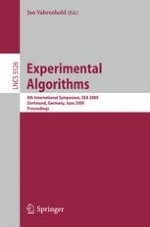2009 | OriginalPaper | Buchkapitel
Competitive Buffer Management with Stochastic Packet Arrivals
verfasst von : Kamal Al-Bawani, Alexander Souza
Erschienen in: Experimental Algorithms
Verlag: Springer Berlin Heidelberg
Aktivieren Sie unsere intelligente Suche, um passende Fachinhalte oder Patente zu finden.
Wählen Sie Textabschnitte aus um mit Künstlicher Intelligenz passenden Patente zu finden. powered by
Markieren Sie Textabschnitte, um KI-gestützt weitere passende Inhalte zu finden. powered by
We study a variant of Naor’s [23] online packet buffering model: We are given a (non-preemptive)
fifo
buffer (e.g., in a network switch or a router) and packets that request transmission arrive over time. Any packet has an intrinsic value
R
and we have to decide whether to accept or reject it. In each time-step, the first packet in the buffer (if any) is transmitted and our benefit of it is equal to its intrinsic value minus the time it spent in the buffer. The objective is to maximize the total benefit. From a worst-case perspective, Fiat et al. [14] gave a threshold algorithm with a competitive ratio equal to the golden ratio
φ
≈ 1.618. Due to the insensitivity of the algorithms towards the input, it was conjectured that this competitive ratio is too pessimistic for packet sequences occurring in practice.
In this paper, we treat this conjecture from an analytical and experimental point of view. In the analytical part, we assume Poisson arrivals and compute a threshold for this algorithm depending on the arrival rate
λ
and the value
R
of the packets. This also yields bounds on the (expected) competitive ratio of the algorithm. We discover the phenomenon that the ratio converges to one if
R
grows or
λ
moves away from one. Thus (for fixed
R
) we have that the largest competitive ratios occur for
λ
= 1. In that case, the bound is essentially
$R / (R - \sqrt{R})$
and gives values smaller than
φ
for
R
≥ 8.
In a second, experimental, part of our study, we compared the competitive ratios achieved by the two threshold algorithms on actual network traffic with our theoretical prediction (which assumes Poisson arrivals). It turns out that the prediction and the measured ratios for our threshold are consistent, where the prediction even tends to be pessimistic. Furthermore, the measured ratios with our threshold where substantially smaller than
φ
and even almost everywhere below the ratios achieved with the threshold of [14].
